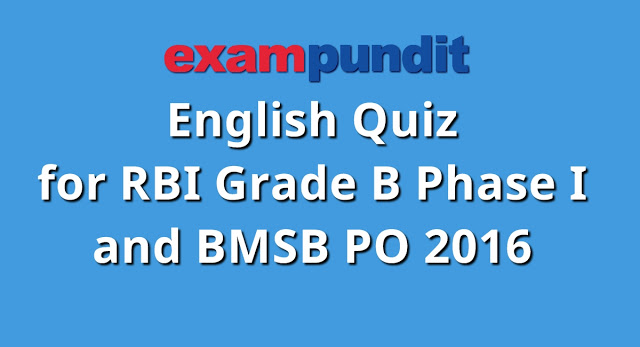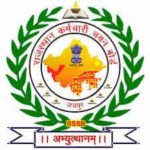Hello and welcome to exampundit . Here is a set of English Quiz for upcoming RBI Grade B Phase I and BMSB PO 2016 Exams.
Directions (Q. 1-10): Read the following
passage carefully and answer the questions given below it.
passage carefully and answer the questions given below it.
India is a great book producing
nation and has a vibrant world of book publishing spread throughout the vast
country in a number of modern languages most of which have their roots in
Sanskrit, the mother of Indian languages. In terms of numbers, there are more
than 16,000 publishers in India publishing 90,000 titles annually in 24
languages, out of which 18 are highly developed, to fulfill the needs of this
multilingual nation. These languages have a galaxy of good authors, their own
publishers and readers of books within their own area as well as spread out in
the entire country. Today Indian publishing is one of the greatest in the world
and can be counted among the first seven publishing nations.
nation and has a vibrant world of book publishing spread throughout the vast
country in a number of modern languages most of which have their roots in
Sanskrit, the mother of Indian languages. In terms of numbers, there are more
than 16,000 publishers in India publishing 90,000 titles annually in 24
languages, out of which 18 are highly developed, to fulfill the needs of this
multilingual nation. These languages have a galaxy of good authors, their own
publishers and readers of books within their own area as well as spread out in
the entire country. Today Indian publishing is one of the greatest in the world
and can be counted among the first seven publishing nations.
We are the third largest
publishers of English language Books after the US and UK. India is the third
biggest market for English publications with almost 12,000 publishers that
publish around 90,000 titles a year in more than 18 languages. India’s main
publishing is in the Indian languages. In India, every year a world level Book
fair is held in New Delhi, which is India’s oldest book fair Delhi Book Fair is
playing a pivotal role in reiterating the might of the pen and the printed word
and has come to be recognised as the biggest annual cultural event and book bonanza
keenly awaited by students, teachers, scholars, authors, intellectuals,
librarians and book lovers. First New Delhi World Book Fair Was held in around
6790 sq. meter area with 200 participants from March 18 to April 4, 1972. It was inaugurated by Sh V.V. Giri President
of India. This biennial event takes
place in early February, and is organized by the National Book Trust, India
(NBT). Delhi Book Fair has evolved over the years as a highly popular conduit
to the world of books and publishers and distributors. The ever increasing
numbers of visitors and exhibitors speaks volumes of its success. The fair
provides a unique platform for business-to-business transactions, establishing
new contacts, entering into co-publishing arrangements, translation and copyright
arrangements, reprinting of old and rare books.
publishers of English language Books after the US and UK. India is the third
biggest market for English publications with almost 12,000 publishers that
publish around 90,000 titles a year in more than 18 languages. India’s main
publishing is in the Indian languages. In India, every year a world level Book
fair is held in New Delhi, which is India’s oldest book fair Delhi Book Fair is
playing a pivotal role in reiterating the might of the pen and the printed word
and has come to be recognised as the biggest annual cultural event and book bonanza
keenly awaited by students, teachers, scholars, authors, intellectuals,
librarians and book lovers. First New Delhi World Book Fair Was held in around
6790 sq. meter area with 200 participants from March 18 to April 4, 1972. It was inaugurated by Sh V.V. Giri President
of India. This biennial event takes
place in early February, and is organized by the National Book Trust, India
(NBT). Delhi Book Fair has evolved over the years as a highly popular conduit
to the world of books and publishers and distributors. The ever increasing
numbers of visitors and exhibitors speaks volumes of its success. The fair
provides a unique platform for business-to-business transactions, establishing
new contacts, entering into co-publishing arrangements, translation and copyright
arrangements, reprinting of old and rare books.
The visitor profile at the fair includes national and International publishers, librarians, researchers, academicians,
writers, students and book lovers Publishers also introduced “e-Books” in this fair. This focus is
being given especially keeping in mind the increasing number of IT-savvy
younger generation with a penchant for internet, mobile phones and other
reader-friendly digital gizmos.
writers, students and book lovers Publishers also introduced “e-Books” in this fair. This focus is
being given especially keeping in mind the increasing number of IT-savvy
younger generation with a penchant for internet, mobile phones and other
reader-friendly digital gizmos.
E-books
and e-publishing both has their obvious advantages though authors in India have
only just begun to realize the immense benefits digital technology can be of in
this field. Also, with the country being the third biggest publisher — after
the US and UK — the potential in this field is immense and the response too has
been quite encouraging so far with a lot of publishers already showing interest
in e-publishing. E-publishing is a boon for both established and wannabe writers as it is cost effective
and cuts down the time it take for a book to reach markets to about a fourth of
what it would have taken had it been left to publishers to do the job. Other
benefits include authors now have a world wide audience to their book which
means better business while debugging or carrying out revisions too is a lot
less hazardous. Another interesting development to have occurred in recent
times is the launch of Amazon e-book store in the country as well as the
availability of the Kindle range of e-book readers. Needless to say, a direct
fallout of the renewed push that e-book are getting is increased sale of ebook
readers and tablet devices.
and e-publishing both has their obvious advantages though authors in India have
only just begun to realize the immense benefits digital technology can be of in
this field. Also, with the country being the third biggest publisher — after
the US and UK — the potential in this field is immense and the response too has
been quite encouraging so far with a lot of publishers already showing interest
in e-publishing. E-publishing is a boon for both established and wannabe writers as it is cost effective
and cuts down the time it take for a book to reach markets to about a fourth of
what it would have taken had it been left to publishers to do the job. Other
benefits include authors now have a world wide audience to their book which
means better business while debugging or carrying out revisions too is a lot
less hazardous. Another interesting development to have occurred in recent
times is the launch of Amazon e-book store in the country as well as the
availability of the Kindle range of e-book readers. Needless to say, a direct
fallout of the renewed push that e-book are getting is increased sale of ebook
readers and tablet devices.
1.
Who had inaugurated the first New Delhi World Book Fair ?
Who had inaugurated the first New Delhi World Book Fair ?
1)
Finance minister of India 2) Prime minister of India 3) Chief of NBT
Finance minister of India 2) Prime minister of India 3) Chief of NBT
4)
President of India 5) None of these
President of India 5) None of these
2.
Which is not a feature of Delhi Book fair ?
Which is not a feature of Delhi Book fair ?
1) B
– 2 – B 2) Co-publishing arrangements 3) Availability of rare books
– 2 – B 2) Co-publishing arrangements 3) Availability of rare books
4) E
– Books 5) None of these
– Books 5) None of these
3.
Which of the following is false in the context of given passage ?
Which of the following is false in the context of given passage ?
1)
People have only craze of variety of Books in the fair not for offer and cash
cow.
People have only craze of variety of Books in the fair not for offer and cash
cow.
2)
New Delhi book fair has completed more than 40 years of its success.
New Delhi book fair has completed more than 40 years of its success.
3)
After US and UK, India has maintained its place in the list of largest
publishers of English Language Books.
After US and UK, India has maintained its place in the list of largest
publishers of English Language Books.
4)
All of the above
All of the above
5)
None of these
None of these
4.
What do you understand by ‘E-books’ ?
What do you understand by ‘E-books’ ?
1)
An Electronic version of only online magazines and books of foreign writers.
An Electronic version of only online magazines and books of foreign writers.
2)
An Electronic version of a printed book.
An Electronic version of a printed book.
3) A
shortened form of a printed book.
shortened form of a printed book.
4)
Both 1 and 2
Both 1 and 2
5)
None of these
None of these
5.
In which of the following language is India’s main epic are available ?
In which of the following language is India’s main epic are available ?
1)
Hindi 2) Urdu 3) Sanskrit 4) Bilingual i.e in Hindi and English
Hindi 2) Urdu 3) Sanskrit 4) Bilingual i.e in Hindi and English
5)
None of these
None of these
Directions (Q. 6-8) : Choose the word which
is most nearly the SAME in meaning as the word printed in bold as used in the passage.
is most nearly the SAME in meaning as the word printed in bold as used in the passage.
6.
Biennial
Biennial
1)
Annual 2) Sprout 3) Weed 4) Shrub 5) Important
Annual 2) Sprout 3) Weed 4) Shrub 5) Important
7.
Conduit
Conduit
1)
Spout 2) Pass 3) Crucial 4) Cardinal 5) Channel
Spout 2) Pass 3) Crucial 4) Cardinal 5) Channel
8.
Gizmos
Gizmos
1)
Tool 2) Gadgets 3) Device 4) Machine 5) Contrivance
Tool 2) Gadgets 3) Device 4) Machine 5) Contrivance
Directions (Q. 9-10) : Choose the word
which is most OPPOSITE in meaning of the word printed in bold as used in the passage.
which is most OPPOSITE in meaning of the word printed in bold as used in the passage.
9.
Pivotal
Pivotal
1)
Unimportant 2) Alive 3) Vine 4) Culvert 5) Windfall
Unimportant 2) Alive 3) Vine 4) Culvert 5) Windfall
10.
Wannabe
Wannabe
1)
Strive 2) Postulant 3) Contestant 4) Hopeless 5) Want
Strive 2) Postulant 3) Contestant 4) Hopeless 5) Want
Regards
Team ExamPundit
This post was last modified on November 27, 2017 8:55 am





